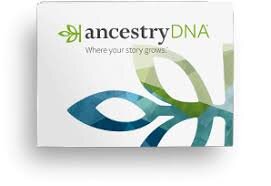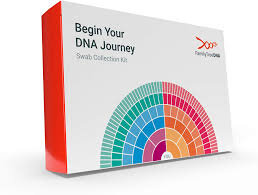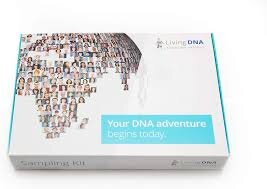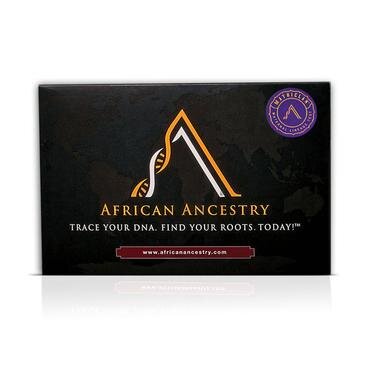DNA testing for home use was launched in the early 2000’s and has grown widely popular in recent years, though some ethic and privacy concerns have been voiced. Do people have a right to own their raw data, and what happens with it? Should the government have access to DNA databases for their own use, in the pursuit of criminals? Will employers use your DNA results against you? These are just a few of the largely unanswered questions that will likely be debated in future courts, and you should be cautious about your privacy and rights when considering this method of research.
This DNA testing can be a very powerful tool, however. It can prove (or disprove) relationships between families, show us where our ancestors may have lived, and help us learn our ethnicity. Some tests can even tell us valuable health information about our inherited traits. Be aware that these results may be unexpected or even unwelcome for some.
With a procured sample, usually some saliva or a cheek swab sent in by mail, a DNA testing company will look at specific locations of a person’s genome (or complete set of nuclear DNA) to determine your genealogical relationships and your estimated ethnic background by comparing your DNA with others. Many tests will also offer the names of your identified relatives that have also taken the same test and allow you to contact them.
There are three general types of DNA tests:
Autosomal DNA (atDNA) : the DNA you inherit from all of your ancestors. The most common type of test, will show an ethnicity estimate and your DNA matches going back 4 - 6 generations. Both AncestryDNA and 23andMe are examples of autosomal DNA testing companies.
Y Chromosome (Y-DNA): the DNA males inherit from their direct paternal line, passed down from father to son. Shows the genetic mutations of SNPs (single nucleotide polymorphisms) on a genome that are passed down to descendants. Looking at the history of SNP mutations through history, people have identified where and when certain groups of humans lived. Only males can take this test, but a female can ask her father or brother to take it. May be used to determine if two families with the same surname are related.
Mitochondrial DNA (mtDNA): the DNA both males and females inherit from their direct maternal line, passed down from a mother to all her children. Anyone can take this test. FamilyTree DNA offers a mtDNA home testing kit for purchase.
DNA Home Testing Kit Options
If you are looking to learn a little bit more about your ethnic background, your personal health, or to find relatives, these home testing kits can help. Consider carefully which one matches your needs. You may want to have your immediate family take the tests as well for expanded matches.
*All images and logos copyright of their respective companies. All opinions are my own. Amazon links are affiliate links in which I may earn a commission.
For a full, detailed comparison of a variety of tests, we recommend: The International Society of Genetic Genealogy’s Autosomal DNA Testing Comparison Chart.
Interpreting Results of Tests: Ancestry and Ethnicity Estimates
When you receive your ancestry DNA test results, you will be given estimates of your ethnic background, or where your ancestors are most likely from. It will be a percentage breakdown by general region starting with the highest percentage, such as 33 % France, 28 % Ireland & Scotland, 27 % England, Wales & Northern Europe, 5 % Spain, 2 % Italy, and so on.
Despite what many believe, there are no unique identifiers on your genes that say “Italian” or “French”. These results have been interpreted by the testing companies, who have compared your DNA results with their pool of data from other users in their database and their reference panel of DNA samples taken all over the world, along with some other calculations and algorithms, and determined you most closely match those with known Italian or French heritage. Note that all DNA testing companies have their own set of reference groups and regions tested to compare with your data, and their own testing algorithms, which mean two companies can have different results.
What does it mean to be from a certain region? Do these results mean my ancestors lived there hundreds of years ago or just a couple generations back? In AncestryDNA results, you can tell which regions are from their reference panel “made up primarily of people whose family have long-standing, documented roots in a specific area”, and their ‘Genetic Communities’ which “show areas where your ancestors may have lived more recently” (from Ancestry.com DNA FAQ) . The regions based on the reference panel have a solid circle, while regions based on communities have a dotted circle.
When these testing companies were building their reference panels and databases of regional data to compare with your results, they sampled DNA from people who lived about five generations in the same area. No company tested the same individuals. Each company has a different amount of regions tested (23andme claims 1500+ geographic regions, while Ancestry tests for 1,000+). If they can’t match a segment of your DNA to a specific region exactly, they may assign it to the next closest region.
You should also know that ethnicity estimates are in fact estimates. Results are more confident at the continental level, and get less confident within each region narrowed down. For example, 23andme uses a only default 50% confidence level to report ethnicity (source article) so if they determine you to be 19% Italian there’s a 50% chance they are incorrect. This confidence level is adjustable in increments between 50 - 90% in user settings, and can greatly affect your results. Meanwhile AncestryDNA does not allow you to adjust the confidence level, but they do tell you a range of possible percentages, as in that 2 % Italy could actually be anywhere from 0 to 5 %.
Interpreting Results: How they Change, and How they Differ
Can your results change over time? Yes, though your DNA will not change, but the way they interpret the DNA will. As more people use DNA tests, the companies’ databases will expand and their algorithms will improve. As a result, ethnicity estimates will change. Some companies automatically update your results to reflect these changes.
DNA test results can also be different between siblings, even ones that take the same test. While everyone inherits half of their DNA from their father and half from their mother, the DNA inherited is random. A brother could inherit different gene segments or markers than a sister. These differences could have a big effect on ethnicity matching, if one sibling inherited more DNA similar to those from a certain region, or impact other factors companies use to determine their results.
Even the slight DNA change between siblings or parent and child could have different DNA matching results with other users in the database, which is why people looking for DNA matches in their family tree can have their whole family take DNA tests for improved matches.
Interpreting Results of Tests: DNA Matches
When you are shown a list of matches in your test results, they will likely display a number or percentage along with the name of your match, and perhaps an estimated relationship based on this number or percentage. Here’s how they calculate this match.
Centimorgans, abbreviated as “cM”, is the distance between chromosome positions, used as a unit of measuring genetic relationships. Technically the term is shown centiMorgan, and is also known as a map unit (m.u.). Centimorgans were named after geneticist Thomas Hunt Morgan. Tests like AncestryDNA, 23andMe, FamilyTreeDNA and MyHeritageDNA use centimorgans to measure the amount of matching DNA across shared segments (though 23andMe tells you results in percentage of DNA shared). The more shared centimorgans in common the more likely a shared common ancestor, and the closer related you are.
The total length of all your chromosomes combined is around 7400 cM. Since everyone inherits half of their DNA from each parent, you would share half of 7400 cm or about 3700 cM with each parent.
| Amount Shared cM | Likely Relationship |
|---|---|
| 3,275 - 3,700+ | A parent or child relationship |
| 2,400 - 2,800 | A sibling relationship |
| 1,450 - 2,050 | Half-sibling, niece, nephew, grandparent, grandchild, aunt, or uncle |
| 680 - 1,150 | First cousin, great-grandparent or great-grandchild, half-nieces and half nephews, great-nieces or great nephews, half siblings, great aunts and uncles |
| 200 - 620 | Second cousin, first cousins once-removed, half-first cousins (share one grandparent), great-great-grandparents or great-great-grandchildren, great-great aunts and great-great uncles, great-great-nieces and great-great-uncles. Also first cousins twice removed, half-first cousins once removed. |
| 90 - 180 | Third cousin, half-second cousins, second cousins once or twice removed, first cousins twice or three times removed, third cousins once removed |
| 20 - 85 | Fourth cousin |
| 60 - 20 | Fifth through eighth cousins |
The above are estimates and not an exact determination of relationship. Beyond immediate family DNA matches, relationships are harder to determine. Someone with about 300 shared cms could even be a third cousin, even though third cousins usually only share up to 180 cms. Someone with 68 shared cms could be also be a third cousin, even though the reference chart shows likely fourth cousins. Some tests will tell you the longest segment or block shared (not available in AncestryDNA) .
Try out this interactive Shared cM relationship tool at DNA Painter to enter the amount of your cM and learn possible relationships.
You might also consider contributing to The Shared cM Project (ScP) at the Genetic Genealogist to help fellow genealogists study the amount of shared centimorgans between known relationships.
What does it mean when a cousin is once-removed? “Removed” refers to a difference in generations. While your cousin is the same generation as you, your cousins child would be “your first cousin once removed” since they are one generation below you. A first cousin once removed could also refer to one of your parent’s cousins, as they would be a generation above you. (See our Cousins Chart)
You should only use the amount of shared DNA as an estimate to determine relationships, and to help you start looking for evidence to determine your common ancestor. Reach out to your DNA matches through the testing company website and see if they can offer any insights. You can also look for patterns in your DNA matches. Do a few of them have similar surnames you could research?
Your DNA Data in Your Control
What can you do with your data? Some home testing companies give you access to download your own RAW dna data. You can then upload these files to other databases to learn more information about yourself or find more DNA matches.
Download your raw dna data from: AncestryDNA, 23andme, FamilyTreeDNA, and MyHeritage
Sharing this information may also improve companies’ research algorithms or help others. However, you should always think carefully about who you are giving your information to and what they might do with it.
Where to upload your data files:
GEDMatch - free DNA matches with many registered users, also offers DNA analysis tools
LunaDNA - contribute to scientific research, community owned platform. Free.
DNA Land - contribute to scientific research, free.
Genomelink - offers personality and genetic traits, 25 reports free, 170+ available for $
Promethease - scientific health and genetic findings based on SNPedia.com, $
Silverberry Genomix - health and wellness reports, free basic wellness report, multiple other options including fitness packages and premium DNA wellness packages, $
Sequencing.com - marketplace of apps and reports, many to choose from, $
Genopalate - use your DNA to examine your nutritional needs, $
Vitagene - health and wellness DNA reports, $
Fitness Genes - DNA testing for fitness and weight loss, $
DNAFit - health and wellness, $
DNA Romance - online dating with DNA (and personality tests), $
You can also upload your DNA data to other testing companies. Even if you haven’t tested with them, you can upload to sites like MyHeritage, Family Tree DNA, and LivingDNA for free limited results and DNA matches. Most will let you upgrade for a fee as well.






